M. Isidora Forrest's Blog, page 4
April 27, 2025
An Egyptian Rite for Making Offering to Isis
I often find it easier to keep up my spiritual practice when I have something “set,” something specific, to do. Like a small ritual that I’ve pretty much got memorized. Is that true for you? If so, then today I’d like to share with you just such a small ritual. This one is an offering rite. It is adapted from the Daily Ritual in the Egyptian temples. (If you have your new copy of Offering to Isis, a version of it is in there. Here’s a version you can use, and of course, adapt, as you choose.)
I’ve called this one the Adma Iset, “Offering to Isis.” Adma is one of the (many) Egyptian words for an offering rite. I preferred the sound of this one compared to some of the others, so I adopted it. Based on Egyptian temple rites, this ritual is adapted for a single person instead of a temple-full of folks.
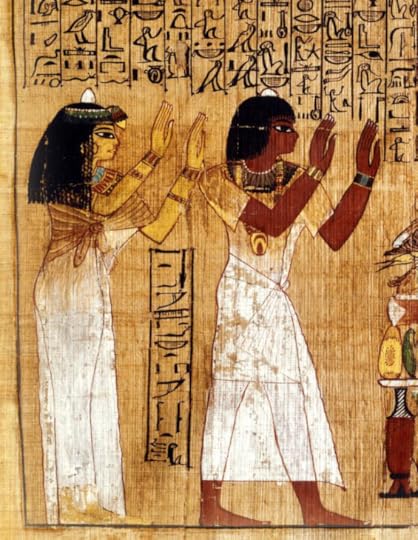 The Gesture of Adoration
The Gesture of AdorationThe Adma Iset
Ritual Tools: A cup or other vessel of pure water; a censer with charcoal and incense; fire starter for incense; an offering (this can be anything you choose: milk, beer, flowers, a poem, a dance); a small reed mat (such as a table place mat); a shallow tray of sand large enough to place one foot in; a bundle of fresh plants for sweeping the sand. These last two are optional, but are adapted from things they actually did in Egyptian temples. You can do this rite at your altar; I will assume you have a sacred image of Isis on your altar.
Ritual Preparation: Prepare your offering as needed; set the small reed mat on the floor before the altar; place the tray with sand and the fresh plants conveniently to the side.
Purification & Consecration
Sit comfortably before your altar, breathing slowly, clearing your mind. When you are ready, rise, approach the altar of Isis, and bow politely.
Ritualist: (Raising your hands in a gesture of adoration) Isis is all things and all things are Isis.
Take up the cup and elevate it.
Ritualist: (To the Purifying Powers) O, You Souls of Night, Water Dwellers, Purifiers, You of the Pure Water from the Sycamore Tree of Isis, I have come for you. By the Blood, by the Power, by the Magic of Isis, establish yourselves within this vessel!
Lower the cup to heart level. Visualize blue light coming into your body from above, let it move through your body into the earth, then bring it back up into your heart, then into the cup as you vibrate.
Ritualist: (Vibrating) ISET MU [EE-set MOO; Egyptian: “Isis of Water”]!
Circle your ritual space, sprinkling water, then sprinkle yourself.
Ritualist: (Speaking while walking) Isis is pure. The temple is pure. The temple is pure. I am pure. I am pure with the Purity of Isis. I am pure with the Purity of the Goddess. (Repeating until you return to the altar; then repeat as needed until you feel the truth of your statement.)
Ritualist: By the Magic of Isis, it is so!
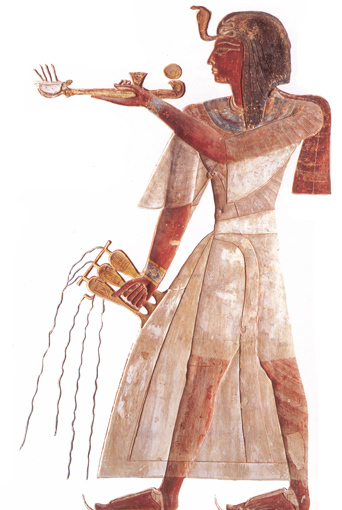 A priest purifying and consecrating
A priest purifying and consecratingReturn cup to altar, take up censer and elevate it.
Ritualist: (To the Consecrating Powers) O, You Souls of Day, Fire Dwellers, Consecrators, You of the Pure Breath from the Mouth of Isis, I have come for you. By the Blood, by the Power, by the Magic of Isis, establish yourselves within this censer!
Lower the censer to heart level. Visualize red light coming into your body from above, let it move through your body into the earth, then bring it back up into your heart, then into the censer as you vibrate.
Ritualist: (Vibrating) ISET ASH [EE-set AHshh; Egyptian: “Isis of Fire”]!
Circle your ritual space, censing it and then yourself.
Ritualist: (Speaking while walking) Isis is consecrated. The temple is consecrated. The temple is consecrated. I am consecrated. I am consecrated with the Fire of Isis. I am consecrated with the Flame of the Goddess. (Repeating until you return to the altar; then repeat as needed until you feel the truth of your statement.)
Ritualist: By the Magic of Isis, it is so!
Entering
 Opening the Shrine
Opening the ShrineFace the altar and make the Gesture of Adoration.
Ritualist: Isis is upon Her Throne. The spirits awaken! They awaken in peace for they know that I have come to make offering unto this Great Goddess.
Put your palms together and extend your arms straight out in front of you. Slowly open your arms as if opening a heavy curtain. This is the gesture of Opening the Shrine. Place the tray of sand before the sacred image and step in it to leave a footprint in the sand.
Ritualist: The sacred doors are opened to me. The light goes forth. It guides me on a fair path to the place where the Great Goddess is. I approach Your shrine, O Isis.
Offering to the Uraeus Goddess
Take up the censer and elevate it.
Ritualist: (Addressing the Uraeus serpent form of Isis) The Sacred Eye is powerful. Lady of Flame, Great One Who is between the horns of the Sunshine Goddess, accept this perfume and let me enter in peace.
Place the censer in your dominant hand, resting on your upturned palm. Bring that hand to your heart. Breathe in and visualize light glowing around the censer. Slowly swing your arm outward toward the image of the Goddess. Visualize the light flowing from the incense smoke to Her sacred image. This is the Gesture of Giving. Return the censer to its place.
Invoking the Goddess
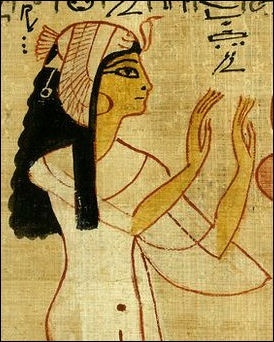 Priestess (or queen) invoking
Priestess (or queen) invokingStand before the sacred image. Place your palms together in front of you as if preparing to applaud. Bring them apart to a comfortable distance, remaining thumbs up. To make the Gesture of Invocation, move the tips of your fingers towards you in a ‘come to me’ gesture. Do this slowly and gently as you speak the invocation below.
Ritualist: Iu en-i. Iu en-i (Eeoou-en-EE; Egyptian: “Come to me”). Come to me, come to me, Beautiful, Great One—Isis of Many Names, Great of Magic, Great Mother, Great Goddess. Come to me, come to me! (Vibrating) ISIS. ISIS. ISIS.
See within your heart the light of the Goddess. Feel it glowing with sun-bright warmth and beauty.
(Speaking to the Goddess) Fair is Your coming to Your temple, Isis. Beautiful is Your appearance in my heart.
Place your hand upon your heart, breathe in, and on the out-breath, move your hand toward the altar and send that light into the sacred image of Isis.
Making Offering
 Offering incense
Offering incenseYou may continue to stand or be seated at this time.
Ritualist: My body being on Earth, my heart being awake, my magic being in my mouth, O Isis, I make offering unto You.
Take up your offering. With open heart, speak aloud why you have chosen to give that particular offering for the Goddess.
If your offering is physical, use the Gesture of Giving (above) to offer it to Isis. If it is not, visualize a symbol representing it in your palm as if it were physical. Breathe in, visualize light around the offering, then on the out-breath, move your hand toward the altar and see that light transfer to the sacred image of Isis. Then, if your offering is performative, perform the offering (e.g. read the poem, dance the dance).
The Reversion of Offerings (optional section)
Standing, make the Gesture of Adoration toward the sacred image of Isis. Close your eyes and visualize the Goddess tracing an ankh symbol over the offering you have given. It glows with the power of Life, the power of Her Divine Ka. She breathes a blessing into it. She breathes a blessing into you. Breathe Her breath and be blessed.
Ritualist: The offering is reverted. Its blessing comes to me. Its blessing goes out into the world. Its beauty endures forever.
Note: Offerings such as food and drink, once reverted, may be consumed by you and your household. Non-consumable offerings may be kept on Isis’ altar or kept in some other convenient place nearby.
Closing the Temple
Once again, take some time to see the light of what you have given glowing around the sacred image of Isis. Let yourself know that She has accepted your offering. Feel Her blessing upon you in return.
When you are ready, take up the bundle of plants and sweep away the footprint in the sand. Make the Gesture of the Closing of the Shrine (the opposite of Opening the Shrine above).
Ritualist: I have flourished on water. I have grown on incense. I have climbed up on sunbeams. O Isis, give me Your hand for I have made offering unto You.
Be in peace, Isis, be in peace. Amma, Iset (AH-ma, EE-set; Egyptian: “Grant that it be so, Isis”).
The Adma is finished. Exit the ritual space or remain in meditation as desired.
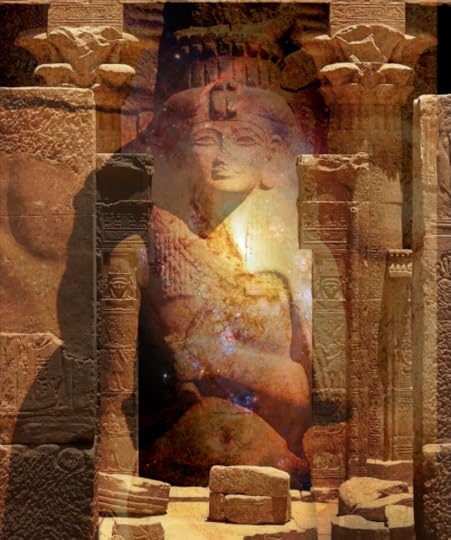 Be in peace, Isis, be in peace. Amma, Iset.
Be in peace, Isis, be in peace. Amma, Iset.
April 20, 2025
Isis & Her Manifestations
More from the Temple of Isis at Dendera.
In this one small, mostly destroyed temple, there are many Deities speaking.
They are everywhere, on every wall. Many are well known, like Tefnut and Hathor and Thoth; some more obscure. The king—always said to be beloved of Isis and Ptah—is ubiquitous as well as he makes many different offerings of many different kinds. And, as this is the temple of the birth of Isis, She Who is First Born Among the Goddesses, there is much rejoicing in this small temple.

For example, the Goddess Merit, the Enchantress Who is here called “Lady of the Throat,” uses Her beautiful throat and voice to arouse joy and bring intoxication; She also leads the dances for Isis. Isis Herself is Mistress of Intoxication Who Arouses joy, Whose Heart is Satisfied with Revelry. Nuet declares that She “makes every person rejoice to see You [Isis].” Hor-Ihy, a combination of Isis’ son Horus with Hathor’s son Ihy, plays the sistrum “for the Mistress of the Sistrum-Temple, Isis the Great, Mother of the God.” The Gods dance for Her. The Goddesses are joyful for Her. The women play the tambourine for Isis the Luminous One. Hathor, Mistress of the Sweet Breath, sings for Her.
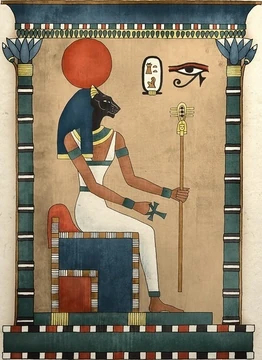
A lot of what we find in this temple, as we did in Hathor’s, are the various names of the Goddess Isis in other parts of Egypt. Interestingly, an inscription on this temple is also one source for our understanding of the Goddess Bast (or Bastet) as “the soul of Isis.” It comes from one of those inscriptions where Isis is being described as a Goddess of various names in other Egyptian locales. And one of those names is
“Nbt B3st (Lady Bast or the Lady of Bubastis) is the Heliopolitan. B3 n 3st [ba or “soul” of Isis] it is said of Her name. B3t is Her name in the mouths of human beings from ancient times of the Deities until now.”
We can be pretty sure that the Egyptians were engaging in some word play here—word play that is intended to reveal mysteries. If you look at the transliteration (writing the hieroglyphs in “latin” or “roman” letters; with the addition of some special characters) of Bast’s name and Isis’ name, you will see that the letters for Isis are within the name of Bast: B3st and 3st. The “3” here does not really represent a three, but is one of those special characters; it is sometimes called aleph, from Hebrew, because it is a consonant that is also “sort of” a vowel, as aleph is in Hebrew. For simplicity’s sake, we are usually told to pronounce it like an English long “a,” (ah). But it isn’t really an a. It’s a glottal stop. Here’s how that works in Isis’ Egyptian name.
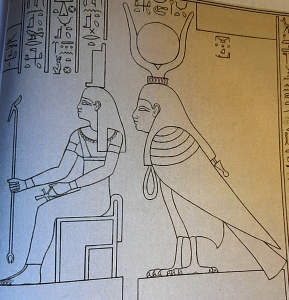 Two forms of Isis from Dendera: anthropomorphic and in Her Ba form
Two forms of Isis from Dendera: anthropomorphic and in Her Ba formSo, what the Egyptians were telling us is that Bast and Isis are linked because from within the name Bast, Isis is revealed. This is expressed by writing that B3 n 3st [Ba/soul of Isis] it is said of Her name.” But “ba” in Egypt isn’t really what we usually mean by “soul” though that is a conventional translation. The concept of the ba is much, much more complicated—and I’ll post on that sometime, but not today.
But in short, ba is one way that a Deity can express Themselves. Ba is an active manifestation of a Deity. So a better way to think about it would be that Bast can be a manifestation of Isis. Or that Isis can express Herself as Bast. This is very much in line with the very fluid way Egyptian Deities can flow into or become each other or express Themselves as each other.
In the final line of this section of the inscription, it says B3t, or Baet, is Her—in this case, Isis’—name “from ancient times of the Deities until now.” This is not a reference to the Cow Goddess Bat or Ba-et. Instead, it is an expression of Isis’ immense power. The ba-power of a Deity made manifest is often written in the plural, bau, though often treated as a singular. The plurality not only intensifies the power, but also recognizes that the Deity is not limited to a single manifestation of power. For example, wind is the bau of Shu. The stars are the bau of Nuet. And both have other bau as well.
Thus to be the Goddess Baet, Whose very Name—from ancient times until now—IS this ba-power, is to be powerful indeed. We learn about Isis’ bau in other inscriptions at Dendera as well. She is said to be the One “Whose bau is great.” In fact, “Her bau is greater than all the Gods.” As a Baet Goddess, She shares this great might with only few other Goddesses, such as Hathor, Neith, and Nephthys. As a Baet Goddess, She shows Her power on earth, where humankind bows to it, and in the heavens, where She is B3t em pt, the Mighty One in the Sky.

On another wall of Her temple, at least a dozen Deities “open the New Year” for the Daughter of Nuet, Isis the Goddess. We even have the founding date for the current temple: July 16, 54 BCE. That was the day of the heliacal rising of the Star of Isis, Sirius, and—the temple records—that for a brief time that morning, both moon and sun were seen in the sky. So both Re and Osiris were there to greet Isis at the foundation of Her Horizon or Akhet Temple. It is so called, no doubt, due to its orientation to the east and the rising of Her Star, as well as the regenerative power of the liminal space of the Akhet.

We also learn that,
“On this beautiful day, the Day of the Child in His Nest, [there is] a great festival throughout the country, Isis is given birth at Dendera by Thoueris [meaning the Great One, in this case, Her mother Nuet] in the temple of the Venerable [Isis].”
And that Isis was born as
“a woman with black (kemet) hair and red (desheret) skin, full of life, Whose love is sweet.”
This must also be word play, for Isis is born with the colors of the Black Land and Red Land shown forth in Her Divine form and so She rules over both; She rules over all things.
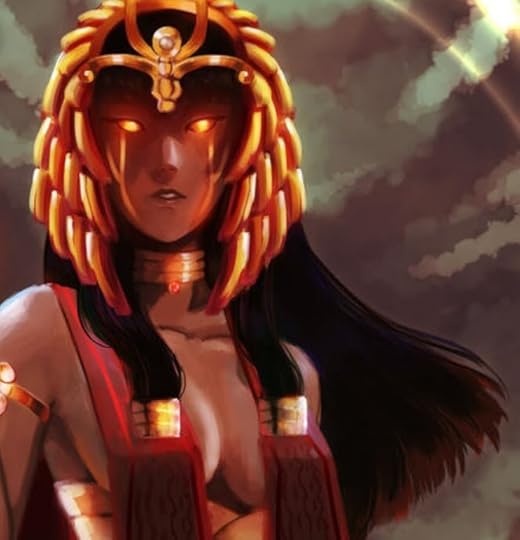
Indeed, even from before Her birth, Isis was destined to rule.
“Destiny distinguishes Her on the birthstones. Her heart is rich in all virtue. The south is given to Her until [that is, “as far as”] the [place of the] rising of the Disk, the north until the limits of Darkness. She is mistress of the sanctuaries of Egypt with Her son and Her brother Osiris.”
Isis is Queen of Upper and Lower Egypt and She rules the Two Lands “from the bricks of birth.” She is the ruler of cities and sanctuaries; indeed She is the Venerable One Without Equal, the Regent Who Governs the Universe.
Just as Isis’ own birth is celebrated in this temple, so Her birth-giving to Horus is also celebrated. Isis is called “the Primordial, the First to Give Birth Among the Goddesses, the One with the Beautiful Face, Whose Milk is Sweet.”
I’ve just scratched the surface here. There’s definitely more. Next time, we’ll look into some of the birth-associated texts and images to see what we can learn there.
April 16, 2025
‘Offering to Isis’ a look inside
I’m excited to let you know that I received my publisher’s copies of Offering to Isis. And I’m so happy; it is gorgeous. Take a look at this unboxing video to see a little of the interior. And for more details about what’s in it, here’s a post on that.
Oh, and one thing I forgot in the video is that it comes with a sewn-in ribbon to mark your place and stitched binding for durability.
If you’d like your own copy of this beautiful, numbered, limited-edition book, visit Miskatonic Books!
April 13, 2025
The Veil of Isis
 This work is by Ludovic Pinelli; you can purchase a print here.
This work is by Ludovic Pinelli; you can purchase a print here.To Isis, a Veil
En Iset, Behen
This is a gift I bring before Isis the Hidden One, Who, Revealing Herself, Shakes Destiny: an invocation offering of a veil.
For You, Isis, a hiding, a hint, a whisper, an obscuration, a veil.
From behind it, may You send revelations into my sleep. Dreaming, I understand the inner voice and vision; I coax truth from my heart. Yet upon waking, the veil is torn asunder and I only half remember that which was so potent while I lay beneath Your veil.
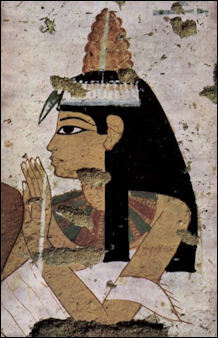 Egyptian woman with headdress
Egyptian woman with headdressO, but I adore Your mystery, Your obscurity, the crooked finger of Your concealing veil! Yes, Goddess, yes—veil Yourself in the depths of the indigo sky, in a blue-green blade of grass, in fire, in eyeshine in the darkness. For I could not bear the full brunt of Your beauty!
Draw me on with insinuations. Call to me with half-answered questions. Lead me with unknowns. And I shall ever follow, carrying the train of Your not-quite-translucent veil, hoping for another brief glimpse of You, beneath it.
Listen, O Isis, to the words of the Veil: “I am offered unto Isis as a kindness to mortals for I am their shield against the awe of the Goddess. Woven of darkness and daylight, the Cosmos itself is the loom upon which I was made. All things are connected to me in warp and woof. Tayet Herself, the Weaver, has made me, a perfect thing. I am the Uniting Mystery Never Quite Revealed. I am the Veil of Isis.”
Unto You, Isis, I offer this veil and all things beautiful and pure. M’den, Iset. Accept it, Isis.
The Veil of the Goddess
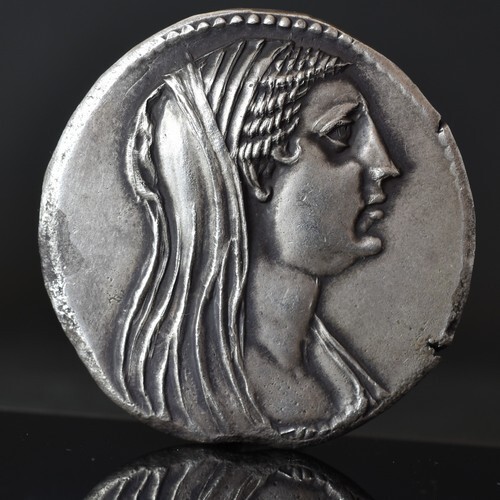 A coin with the image of Ptolemaic Queen Berenike II of Egypt with head veil
A coin with the image of Ptolemaic Queen Berenike II of Egypt with head veilThe phrase “the Veil of Isis” is so common that we might not question where it came from. But perhaps we should. For one thing, ancient Egyptian women generally weren’t veiled so it would be odd to see a Goddess depicted so. Oh, there were headdresses aplenty, but not concealing veils.*
By Ptolemaic times, under Greek influence, we do see veils as head coverings come into use, though they seem more decorative than anything else. Both Greek and Roman images of Isis often include a veil covering the back of the head and hair.
 Sais is a delta city
Sais is a delta cityThe phrase, Veil of Isis, comes to us from our Greek friend, Plutarch in his essay On Isis and Osiris. In it, he is talking about Egyptian Mysteries. He tells his readers that when the new pharaoh was crowned, he became privy to hidden Egyptian philosophy and notes that the Egyptians’ knowledge of their Deities “holds a mysterious wisdom.” To illustrate his point, he notes a certain seated statue of the Goddess of the Egyptian city of Sais. He says She is Athena “whom they [the Egyptians] consider to be Isis also.” She would, of course, be Neith, the Lady of Sais, Who was indeed assimilated to both Athena and Isis.
The statue bore an inscription: “I am all that was, and is, and shall be, and no mortal hath ever Me unveiled.” It speaks to the all-encompassing power and mystery of the Goddess.
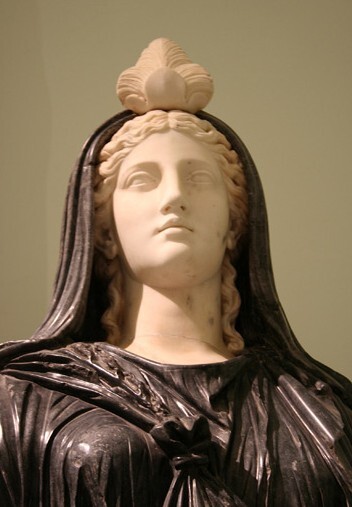 A Roman image of Isis, with veil
A Roman image of Isis, with veilIf there was such an image, we have not yet found it. Since Plutarch was writing in the 2nd century CE and the Ptolemies came in long before that, about 300 BCE, it is possible that the image of Neith-Athena-Isis could have been veiled—at least with the decorative-type veil we see in images of some Ptolemaic queens.
Proclus, a Greek philosopher writing in the 5th century CE, also quotes the inscription and adds another line: “The fruit that I have brought forth the Sun has generated.” He doesn’t mention Isis, but rather Neith-Athena and speaks in terms of the Goddess being involved in creation processes, both visible and invisible.
There are a few other ancient references to the veil of Isis. The Greco-Egyptian magical papyri refer to it on several occasions. In one, the magician invokes Isis and asks Her to remove Her veil in order to reveal the future and “shake destiny.” By revealing the Mysteries beneath Her veil, the magician hoped that the Goddess Who was worshiped as Lady of Fate and Fortune could not only predict, but could change or “shake” destiny.
 Science unveiling a multi-breasted Nature
Science unveiling a multi-breasted NatureEven after the end of the open worship of the Pagan Deities in the Mediterranean, Plutarch and other Greek philosophers continued to be studied. Because of Plutarch’s mention of the inscription in relation to Isis, the idea of the veil of Isis formulated more and more strongly and eventually passed into the annals of the Western Esoteric Tradition. The unveiling of the Goddess became a symbol of the revelation of esoteric secrets, sometimes specifically the revelation of Egyptian secrets.
European esotericists of many kinds came to use the metaphor of the Veil of Isis for the hiding or revealing of their own secrets. By this time, Isis was identified with the Goddess Nature, Who hides Her secrets from those who seek to understand Her.
This idea was particularly important to the alchemists who sought to uncover Nature’s secrets—She Who is Isis and Venus and Ephesian Artemis and the Anima Mundi (World Soul). Freemasons took up the idea of a veiled Isis keeping their own secrets and some even found Egyptian antecedents in their rituals.
 A French occult magazine titled the Veil of Isis
A French occult magazine titled the Veil of IsisThe Romantic movement, which rejected what they considered the coldness of the Enlightenment, preferring emotion and imagination, was also developing at this time. For Romantics, Isis’ veil concealed not just the scientific secrets of Nature, but a deeper, unexplainable Mystery that is, at the same time, Ultimate Truth.
Philosophers took up the metaphor as well. Immanuel Kant said of the Saite inscription: “Perhaps no one has said anything more sublime, or expressed a thought more sublimely, than in that inscription on the temple of Isis (Mother Nature).” Influenced by Kant, the physician, playwright, poet, and philosopher Friedrich Schiller (what a guy!) tells a tale in which a young initiate rashly removes the Veil from a sacred image of Isis and is found nearly dead the next morning by the wiser priests; apparently, the secret was just too much for him.
Following in those mysterious footsteps, Helena Blavatsky’s 1877 book, Isis Unveiled, is a compendium of occult lore that purports to draw aside the veil of the Goddess for its readers. It continues to influence occultists to this day.
As a metaphor, the Veil of Isis was ubiquitous for centuries. Alchemists, magicians, freemasons, philosophers, scientists, poets, novelists, and visual artists all desired to life Isis’ Veil to discover the deepest secrets and truths, truths about Nature and truths about human beings in Nature.
This post barely scratches the surface of the many ways and places people were inspired by the veil of the Goddess. I’ve expressed some of my thoughts in the Offering at the beginning of this post. What is the Veil of Isis for you?
 “Isis, Goddess of Life” on the Herbert Hoover National Historic site. A gift of the people of Belgium in gratitude for Hoover’s famine relief efforts for them in WWI. Engraved on the statue, in French, is,” I am that which was and is and will ever be, and no mortal has yet lifted the veil that covers me.”
“Isis, Goddess of Life” on the Herbert Hoover National Historic site. A gift of the people of Belgium in gratitude for Hoover’s famine relief efforts for them in WWI. Engraved on the statue, in French, is,” I am that which was and is and will ever be, and no mortal has yet lifted the veil that covers me.”* It is possible to see the daily opening and closing of the shrines that held the sacred images of the Egyptian Deities as a kind of unveiling and veiling of the images.
April 6, 2025
‘Offering to Isis’ is here
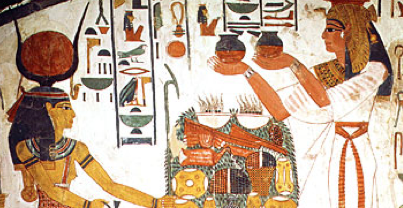 Nefertari making offering to Isis
Nefertari making offering to IsisI (almost) have my author copies of Offering to Isis! It’s been a long time coming, but it’s finally here.
The shipment is on the way from the printer to the publisher even as you read this. So, if you pre-ordered a copy, it should be on its way to you soon. If you’d like to order a copy, it’s available from Azoth Press at the Miskatonic Books website. Here’s the direct link.
I’ll do an unboxing video when I get my copies to show you more of the book. But in the meantime, here are some pics from the publisher:
 Hardback cover in a faience green
Hardback cover in a faience green
 Inside front cover with offering procession
Inside front cover with offering processionI know a lot of you are familiar with Isis Magic, but maybe you haven’t yet come across Offering to Isis. I may be a bit partial, but I really like this book a lot, too.
Offering to Isis is about how we can connect with, honor, and grow our relationship with Isis through the ancient and eternal practice of making offering. Offering is one of the most important ways we human beings have always communicated with our Deities. It was vitally important in ancient Egypt and it’s just as important for those of us interested in or devoted to Isis today.
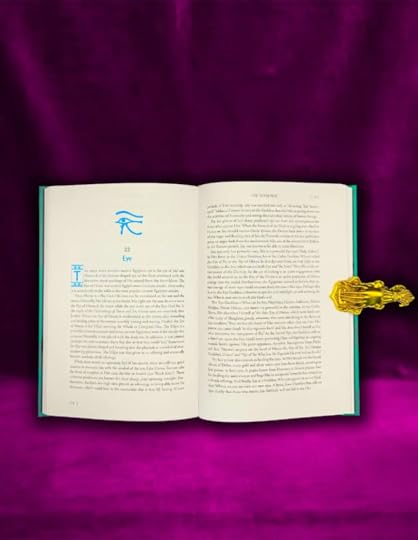 Interior “about the offering” entry
Interior “about the offering” entryIf you’ve ever wondered exactly what sort of things to offer to Isis, Offering to Isis includes in-depth explanations of 72 sacred symbols associated with Isis—symbols that make ideal offerings to Her.
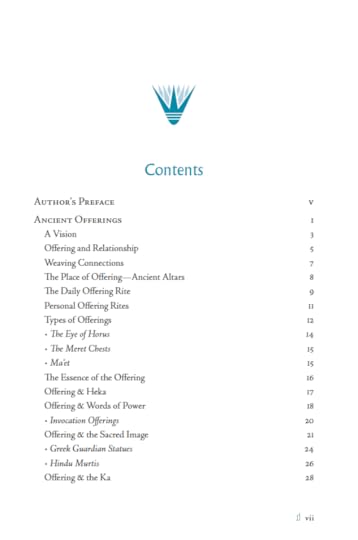 You can download a complete copy of the Table of Contents by clicking here.
You can download a complete copy of the Table of Contents by clicking here.We’ll also talk about the how and why of Egyptian offering practices, including the important and genuinely ancient Egyptian technique of “Invocation Offering.”
There’s information on exactly how the ka energy inherent in every offering is given to and received by Isis—and what to do with offerings once they’ve been received. You’ll also find a selection of offering rituals, from simple to complex, for a variety of purposes. Most rites are for solitary devotees, so I think you’ll find one that works just right for you.
If you’re curious and want to know exactly what’s in the book, you can download a PDF copy of the full Table of Contents by clicking on the caption under the “Contents” image.
The largest section of the book details the 72 sacred symbols of Isis. You’ll add to your knowledge of Isis and Her ancient worship by learning more about Her through Her important sacred symbols. You’ll see how each one is intimately connected with Her and how they may be used in offering rites for Her. Every entry also includes an Invocation Offering that you can use for your own offerings to Isis.
One of the things I especially like about this book is that you can just open it at random and you’ll likely find something you hadn’t known about Her, something that I hope will inspire you in your own devotions. For instance, how did the Knot of Isis come to be Her knot? What stones are associated with Her? What animals are connected with Her? Why are dreams especially important when it comes to Isis?
As it’s been a few years since this book was first published, the text has been thoroughly updated. All the hieroglyphs associated with the offerings have been re-illustrated and are much more accurate—and much more beautiful—in this new edition, too. There’s also a handy appendix in the back for quick reference in finding any offering you may need.
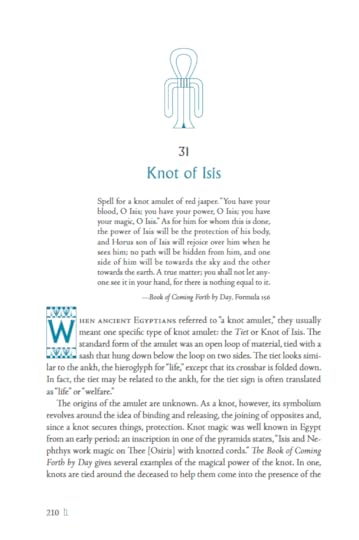 This is what a typical page looks like.
This is what a typical page looks like.This new Azoth Press edition can be purchased only through the Miskatonic Books website. (If you go to Amazon, you will be ordering a 20-year-old paperback edition published by Llewellyn in 2005, which people are trying to sell at very inflated prices.)
Oh yes, and if you’d like, you can take advantage of Miskatonic’s installment plan that lets you pay over several months so it doesn’t take a big bite out of your budget. Plus, the new hardback edition is priced A LOT lower than those overpriced, out-of-print first editions that I’ve seen out there.
When you go to the Miskatonic site, you’ll find two different Azoth Press Offering to Isis editions. For the high rollers, there will be 36 copies in a gorgeous leather-bound and numbered collector’s edition. For the rest of us, there will be 650 numbered, limited edition copies in a cloth-bound hardcover. Both editions are two-color throughout, and more than 400 pages.
Thank you so much for letting me interrupt our regularly scheduled blog post to tell you about this new edition. And would you please do me a favor and share this information with anyone who you think might be interested? Feel free to ask me any questions about Offering to Isis that you’d like, too.
I’m definitely looking forward to getting my copy of this beautiful, new edition of Offering to Isis.
And while you might think it’s strange, even though I wrote the book, I still use it for reference when I’m making offering to Isis. I use the information in it as well as the Invocation Offerings. I hope this new edition will serve you well, too.
March 30, 2025
The Temple of Isis at Dendera
I finally got my interlibrary loan of Egyptologist Silvie Cauville’s Dendara: Le temple d’Isis. And the minute I starting perusing this two-volume set, I knew I wanted to own a copy. So Adam got it for me for my birthday. Yippee!
So now I get to tell you what I’ve been learning.
 The remains of the temple of Isis at Dendera
The remains of the temple of Isis at DenderaThe first thing to know is that, , so Hathor is present in Isis’ smaller Dendera temple.
And, as with many of Egypt’s temples, the current remains sit atop older structures. What we see today at Hathor’s temple is mainly Ptolemaic, while the bulk of what remains of Isis’ temple was constructed under the Ptolemies but completed and decorated during Augustus’ Roman rule.
Hathor’s worship at Dendera is much more ancient than the Ptolemaic period. There is evidence of a temple there from about 2250 BCE, during the reign of Pepi I. There’s also evidence of an 18th-dynasty temple. The Isis temple has earlier roots, too. There are vestiges of structures from the dynastic reigns of Amenemhat I (1991-1962 BCE), Thutmose III (1479-1425 BCE), and Rameses II (1279-1213 BCE). During the reign of Nectanebo I, the temple of Isis served as a mammisi for Isis as She births Horus.
 The Isis temple at Dendera with the sad stumps of a hypostyle hall
The Isis temple at Dendera with the sad stumps of a hypostyle hallOne of the interesting things about the temple of Isis at Dendera is that, due to its older substructures, its current configuration has two main axes: east-west and north-south. Thus the temple opens to all four directions. The main temple entrance and hypostyle hall align with the heliacal rising in the eastern sky of the star of Isis. Sirius’ rising marked the coming of the Inundation and initiated the Egyptian New Year. Opposite, in the west, is the point of descent for Isis’ beloved, Osiris Lord of the Westerners. The north-south axis is marked by carved Hathor heads and connects that Goddess with Her father Re at Heliopolis to the north and with Her spouse Horus at Edfu to the south.
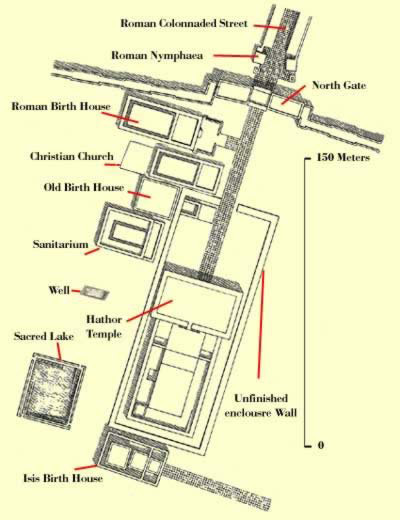 The Isis temple is shown at the bottom of this image, behind the Hathor temple; it is labeled “Isis Birth House”
The Isis temple is shown at the bottom of this image, behind the Hathor temple; it is labeled “Isis Birth House”Blocks from the mammisi of Nectanebo’s time were reused in the Ptolemaic/Augustan temple that we see the remains of today. This temple celebrates the birth of Isis Herself. Her mother Nuet births Her Great Daughter upon the primal Birth Mound, the First Earth. The temple (you will sometimes see it called the Iseum) also celebrates the sovereignty of Isis.
Here then, the Goddess Whose name means “Throne” is the guardian of the throne of Egypt, protectress of the king, and is Herself the regent of all of Egypt. Her Dendera temple is also the place of Her coronation as Divine Queen of the Universe. To me, this universal rulership of Isis is echoed by the temple’s four-directional doorways. Her ruling energy radiates from Her temple out to every corner of the world, if you will. And, if you recall, we learned several weeks ago that Isis’ rulership is so potent that She ruled the Two Lands even even before She was born, from within Her Great Mother’s womb.
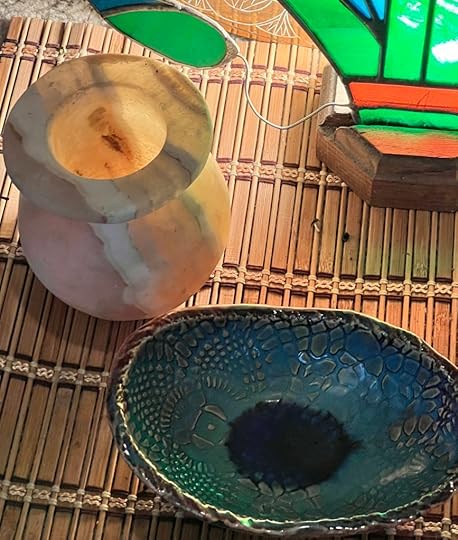 My Per Nu with water vessels; the Nu pot is alabaster and from Egypt; the other water bowl is by a wonderful local artist
My Per Nu with water vessels; the Nu pot is alabaster and from Egypt; the other water bowl is by a wonderful local artistDendera’s temple of Isis consists of three main chambers, the Per Wer, “Great House,” the Per Nu, “House of Water,” and the Per Neser, “House of Fire.” These chambers are also found in the Hathor temple, along the north-south axis. I was familiar with the Per Nu, the water sanctuary, but the fire sanctuary—the Per Neser—was new to me. There is also an offering vestibule in front of these chambers.
It pleases me no end that in our own home shrines and altars, we can easily replicate this ancient Egyptian temple structure.
 My Per Neser with charcoal and incenses; are you staring at my Isis Temple ashtray? It’s masonic and was an ebay find, long ago
My Per Neser with charcoal and incenses; are you staring at my Isis Temple ashtray? It’s masonic and was an ebay find, long agoThe altar is our Per Wer, where the sacred image or images of our Divine Ones live and receive offerings. The Per Nu is where our purifying and libation waters, cups, and other vessels are placed (mine is to the left of the altar). The Per Neser is where the candles, incense, charcoal, and lighters are kept (right side for me). My collection of sistra is also on the Per Neser side. In the House of Isis (see Isis Magic), the sistrum corresponds to Fire because of its ability to “shake things up.” In Egyptian, to “play the sistrum” is iri sakhem, “to do power.” The sistrum is thus an energy generator; very fiery.
I love all this so much that I fully intend to call these parts of Her shrine by these names from here on out.
Since there is so little left of this temple, that about wraps up our tour of the building itself. Next time, I’ll be looking into the inscriptions to see if I can find any new and interesting epithets or lore of the Goddess that I can share with you.
What about you? Do you have a special place near your altar that serves as your Per Nu and Per Neser?
March 23, 2025
Isis & Nephthys: the Mysteries of the Kites
This is a longish post because I found out some things I didn’t know about the Kite, the Kites, and Isis and Nephthys as the Kites. I’ll bet you’ll find out something you didn’t know, too.
Now, what you may already know is that the most consistent avian form that Isis and Nephthys take is the black kite. Black kites are birds of prey. They eat carrion and they hunt live prey. And one of the things I just learned is why they are called “kites.” It’s from their characteristic hunting technique in which they hover over the prey (like a paper kite does at the end of its string) and then do a swift dive to capture it. This highly successful hunting move is called “kiting.”
 Isis & Nephthys with Their kite wings in a pose of protection
Isis & Nephthys with Their kite wings in a pose of protectionSo today, we’re looking into the Kites, especially the Divine Kites, the Goddess Kites. We often see Them as Isis and Nephthys at the head and foot of Osiris’ mummy bier. Sometimes They are in Their bird form, sometimes fully anthropomorphic, and sometimes combining the two forms as women with wings.
In other images, we see Isis as a kite hovering (kiting!) over the erect phallus of a mummyform Osiris in order to conceive Their child Horus. We also find the Kite/s in funerary processions and in the Opening of the Mouth ritual. The Opening of the Mouth is a funerary rite; its main purpose is enlivening. It was used to give life or renewed life to everyone and everything from the mummified king to the sacred statues and images in a temple.
 The magnificent black kite; yes, it’s brown as you can see in the tomb paintings as well
The magnificent black kite; yes, it’s brown as you can see in the tomb paintings as wellEgyptologist Racheli Shalomi-Hen notes that the first appearance of a Kite or Kites is in depictions of non-royal funerary processions of the late 5th dynasty of Egypt’s Old Kingdom. We know who the Kites are in these depictions because they are labeled. In Egyptian, Kite is Djeret while the Two Kites are the Djereti.
Egyptologists usually group the Kite/s in with other professional mourners (as opposed to mourners from the family of the deceased). This is probably because, once the Kites were connected with Isis and Nephthys, They were mourning Osiris. But the Kites seem to have other functions as well.
If the Kites were professionals, it must mean that their roles required special knowledge and skills. Just speculating here, but I wonder whether they were specialized priestesses of some kind. (As an aside, the Kites were also associated with another special funerary ritualist, the Demdjet. You can read about the Demdjet here.)
Shalomi-Hen suggests that the appearance of the Kite/s in these non-royal tombs is an indication that the non-royal dead were already identified with Osiris by that time—earlier that usually thought. At that time, she says, the Kites were not associated with the Goddesses; they were human funerary ritualists.
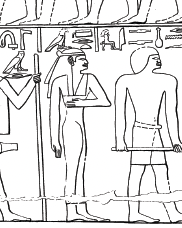 The Kite in a non-royal funeral; her title, Djeret, is above her head, with kite determinative at the end
The Kite in a non-royal funeral; her title, Djeret, is above her head, with kite determinative at the endShe proposes that it was only after the king wanted to be an Osiris, too, that the Kites gained Divine and mythological status—and that this was done for the first time in the Pyramid Texts.
Other Egyptologists think that the basic Egyptian myth cycles, including the Osirian, may have been formed as early as the 2nd or 3rd dynasties—though we have nothing of length written down until the Pyramid Texts.
I’m not convinced that the Osirian myth we find in the Pyramid Texts represents the first time that this myth cycle was formulated. In the Pyramid Texts, we already see the characteristic mythological allusions that assume that scribes and educated readers (such as the priesthood concerned with funerary rites) would understand the reference to the whole myth from just the allusion. If this were the first time the myth was formulated, they would not have been able to do so. Instead, this must mean that—even before such allusions were written down in the Pyramid Texts—there was an oral tradition, and that is where the Osirian cycle first emerged.
In the illustration from one of these non-royal funerals (above), you can see that there isn’t anything particularly bird-like in the Kite’s dress or implements; indeed she has no implements and wears only the usual Old Kingdom sheath dress. Yet she is called the Kite. What then is the connection between the black kite and funeral rites?
Some scholars have suggested that the cry of the black kite may have sounded to the Egyptians like mourning women. I’ve listened to a number of recordings of black kite calls and…maybe? The closest one I’ve found is the warbling call in the last part of this video. The wavering cry sounds vaguely mournful. On the other hand, the kite also has a sharp cry, which caused another Egyptologist to suggest that the kite’s cry might have been thought to wake the dead. Yet another offers that the kite’s participation in funerals may have developed from a prehistoric hunting ritual. I wanted to look into that a bit, so I dug up that article.
In it, Egyptologist Eberhard Otto notes that the Kite is also present in some versions of the Opening of the Mouth ritual—in the part where the foreleg of the bull/bull calf is being cut off and its heart cut out. Sometimes, this female ritualist is identified simply as the Kite or the Great Kite. Sometimes there are two ritualists, the Great Kite and the Small Kite, Who later were identified with Isis and Nephthys.
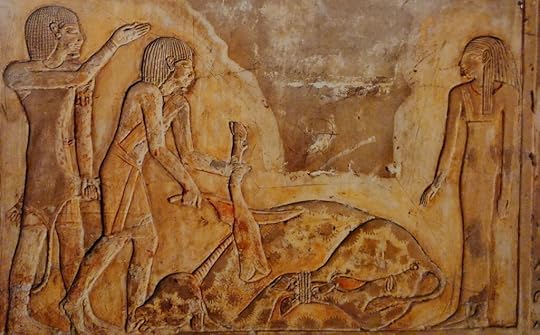 The Kite (right) in the butchery scene from the Opening of the Mouth
The Kite (right) in the butchery scene from the Opening of the MouthIn versions of the ritual where the Kite is present, she/She whispers into the ear of the sacrificial animal, blaming it for its own death. She says, “Your two lips have done that against you.”
Egyptologist Maria Valdesogo Martín identifies the Kite in the New Kingdom scene from the Opening of the Mouth shown here specifically as a mourner. This would be consistent with the well-known functions of the Kite at that time—as well as with the identification of the Great Kite as Isis. And mourning the slain animal is certainly an improvement over victim-blaming.
Nonetheless, this incident did remind me of the myth of the Contendings of Horus and Set in which Isis, in disguise as a maiden-in-distress, tricks Set into admitting that Osiris’ kingdom should go to Horus. Significantly, She first transforms into a kite, then flies into a tree and screeches, “Ha! Your own words have condemned you!”
 The Two Sisters
The Two SistersOtto thinks that the Opening of the Mouth scene with the Kite is the part that may have originated in a prehistoric hunting ritual. He says the Kite is a later representation of a wild kite circling the body of a slain animal. The shrieking cries of the bird may have been interpreted as speech—which in later periods developed into the Kite blaming the animal for its death and, eventually, to mourning.
We begin to see Two Kites rather than just one in depictions of private funerary processions during the 5th dynasty, with most in the 6th dynasty. In the Pyramid Texts of the 5th and 6th dynasties, decidedly royal texts, we learn that the “Djereti of Osiris,” Who can only be Isis and Nephthys, “remove the ill” from the king as part of the preparation for his ascent to the heavens. In other words, They purify the king. What the Kites are removing is said to be poison, which is envisioned as venom from the fangs of a serpent that pours into the ground as the Kites supervise the action.
The Kites also help ferry the deceased king, as Osiris, “across the Winding Waterway” to the Horizon (Akhet) and rebirth. In tomb chapels of the same period as the Pyramid Texts, Kites are shown at the bow and stern of a boat that carries the coffin. We know that they/They are mourning for they/They make known mourning gestures in some cases and protective gestures in others. In these tomb chapels, the Djereti may or may not be identified as Isis and Nephthys.
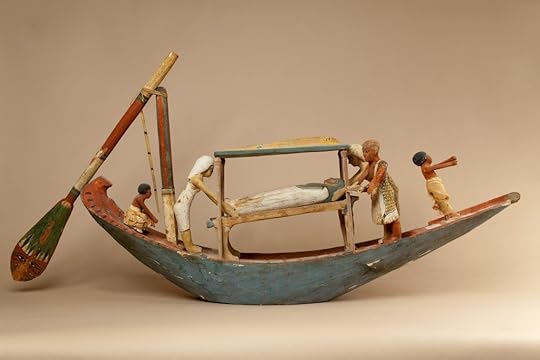 In this model, the Goddesses’ names are followed by personal human names
In this model, the Goddesses’ names are followed by personal human namesWe also find the Djereti represented on model boats since the Kites ferry the dead to rebirth. And here’s something really interesting.
One model boat from the Middle Kingdom includes the names of the Goddesses preceding what seem to be personal names. We see “the Nephthys Hotep-Hathor, justified” and “the Isis Hetpet, justified.” When a human name is followed by maakheru or “justified,” it means that the person is dead and has passed the judgment of Osiris. Perhaps what we are seeing here is previously deceased female relatives of the newly dead person serving as Isis and Nephthys for the deceased to help their loved one cross the Winding Waterway to rebirth.
In addition, the Kites were sometimes connected with the mummy wrappings. The Goddess of Weaving, Tayet, is sometimes identified as a Kite. Isis and Nephthys, known as the Two Weavers, are also Weaving Goddesses. There are a few Old Kingdom reliefs and paintings that show pairs of women labeled as Kites carrying boxes of offerings on their heads. In one example, we learn that they are “bringing khenit-cloth.” Khenit means “yellow” and yellow is the same as gold in Egyptian color symbolism. Thus, this cloth is solar and refers to the daily solar resurrection. Here again, we have the Kites assisting in rebirth. These cloth-bringing Djereti also sometimes have personal names attached to them, indicating that they are human Kites.
 Isis & Nephthys as black kites
Isis & Nephthys as black kitesBy removing poisons, attending to the mummy wrappings, and bringing offerings of yellow cloth, the Kites surely were part of the magical and physical preparation of the body and the tomb, just as female relatives were and are in so many societies, ancient and modern. Perhaps the professional Kites even guided or assisted the relatives of the deceased in these tasks.
Yet so far—with the exception of the kite’s cry interpreted as speech to the sacrificial victim or the possibility that their raptor-cries sounded like mourning—there doesn’t seem to be anything very kite-like or bird-like in the funerary function of the Kites.
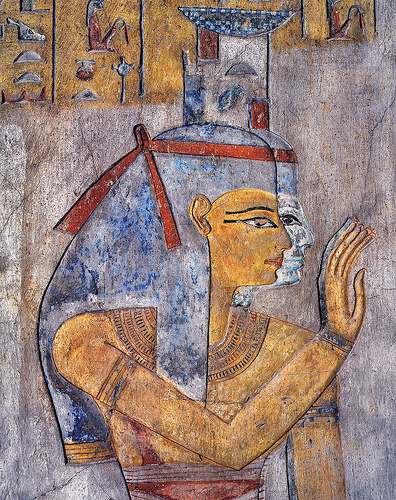 The Sisters as Twins
The Sisters as TwinsBut then there are those wings. Those bird wings, those kite wings.
The wings of Isis and Nephthys are Their most obvious avian attributes. As birds, the Kites fly; as birds of prey, They hunt.
As far back as the Pyramid Texts, the Two Sisters are the ones Who seek—or hunt for—Their missing brother Osiris. Their wings give Them the power to search a vast territory in a shorter period of time. Their lofty vantage point and sharp birds-of-prey vision make Them successful in their hunt.
In the Pyramid Texts, Osiris has not been dismembered, only killed. Yet when His dismemberment does become part of the myth, it isn’t much of a stretch to imagine the carrion-bird Sisters scavenging for the parts of the God’s body to re-assemble Him and make Him whole.
 Isis protecting with Her wings
Isis protecting with Her wingsIn the Hymn to Osiris in the Book of the Dead, Isis uses Her wings to revive Osiris enough so that She can conceive Their child and heir. “She made light with Her feathers, She created air with Her wings, and She uttered the death wail for Her brother. She raised up the inactive members of Him whose heart was still, She drew from Him His essence, She made an heir…” the text tells us.
In Egyptian lore, wings are also protective. Many are the Goddesses, wings outspread, Who protect tombs, sarcophagi, doorways, and temples. There are also a number of surviving statues of a larger Isis with a smaller image of Osiris protected between Her wings.
I remain on the lookout for more about the Kite Goddesses (as well as the human Kites). But for now we can know that Their wings are protective, Their cry can be mournful or accusatory, Their wings and vision make Them successful hunters and searchers, They can purify and prepare the dead for resurrection, and They can help “ferry” the dead toward the Horizon of Rebirth.
 The Kite stands 4th from the right, bottom row; perhaps another Kite is on the top row, 6th from the left; I am assuming the family of the deceased are the people in mourning disarray on the bottom left
The Kite stands 4th from the right, bottom row; perhaps another Kite is on the top row, 6th from the left; I am assuming the family of the deceased are the people in mourning disarray on the bottom left
March 16, 2025
Is Isis “She Who Must Be Obeyed”?
We learned several weeks ago that one of the things said of Isis at Denderah is, “Life is in Her hand, health is in Her fist, one does not oppose what comes from Her mouth.” But was H. Rider Haggard’s Ayesha—of “She Who Must Be Obeyed” fame—based on Isis and/or Isis-connected literary characters?
 Betty Blythe as Ayesha in She, 1925
Betty Blythe as Ayesha in She, 1925Let’s see what we can find out.
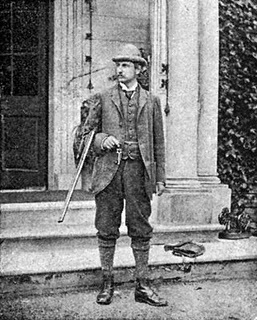 H. Rider Haggard
H. Rider HaggardFirst, who is Ayesha? Well, unless you are a fan of Victorian gothic novels or the British TV show Rumpole of the Bailey, you may not have heard of her.* Ayesha is the title character in the novel She: A History of Adventure by the English writer H. Rider Haggard. Haggard wrote adventure-romances set in exotic locations, mainly Africa, inspired by his having lived there for six years.
Along with King Solomon’s Mines, which introduced the character Allan Quartermain, She is Haggard’s most renowned work. It was enormously popular. First published in 1887, it has never been out of print and has sold over 100 million copies. Haggard was one of the innovators of the “lost world” genre and She is a classic example of that genre.
 One of the many book covers for the novel
One of the many book covers for the novelAyesha is the mysterious “white queen” (I know, cringe) of an equally mysterious tribe living in the African interior. Ayesha is worshiped by her people as Hiya, She Who Must Be Obeyed, or simply She.
The novel has been studied and both praised and criticized for its depictions of female authority and power.
The Victorian and early-Edwardian era was also host to a wide-ranging male preoccupation with the “True Nature of Woman,” and mostly, in their cogitations, Woman’s True Nature tended toward the evil, perverse, and degenerate. This is where all those vampiric fin de siecle femmes fatales that populated a good portion of the art world at that time come from.
 The Evil Mothers by Giovanni Segantini, 1894
The Evil Mothers by Giovanni Segantini, 1894“The Woman Question” was much-discussed as the rise of the more-liberated, educated, and independent New Woman terrified the traditionalists. (And why are we still and again having to have this infuriating and exhausting discourse?)
But back to Ayesha.
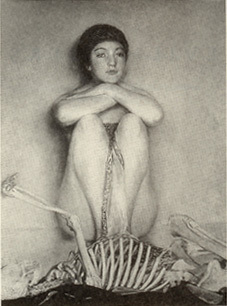 Sphinx by William Sergeant Kendall, 1915
Sphinx by William Sergeant Kendall, 1915Ayesha is a powerful sorceress who has discovered the secret of immortality. She’s been waiting 2,000 years for the reincarnation of her lover, who she killed when he refused to murder his wife to be with her. Yes, it’s complicated.
Our heroes, Cambridge professor Horace Holly and his adopted son Leo Vincey, travel to Africa in search of a lost civilization—and find it with Ayesha and her people. When Holly is ushered into her presence, she is veiled and warns him that the sight of her arouses both desire and fear. And this is so, for when she unveils herself, Holly falls to his knees before her, bespelled. Ayesha and her people live in the lost city of Kôr, a city of the people who predated the ancient Egyptians. Ayesha was born among the Arabs and studied the wisdom of the ancients to become a great sorceress.** In deepest Africa, She learned the secret of immortalization in the fiery Pillar of Life.
Ayesha is convinced that Holly’s adopted son is her reincarnated lover. She wants him to step into the Pillar of Life as she did so that he, too, can be immortalized. (Anybody getting Mummy movie vibes?) To prove to him it’s safe, Ayesha makes a fatal mistake, again walking into the burning Pillar herself. With her second exposure, her immortality is reversed and she dies—but with her last breath vows to return! Holly and Leo are freed from her deadly spell and hightail it home to England.
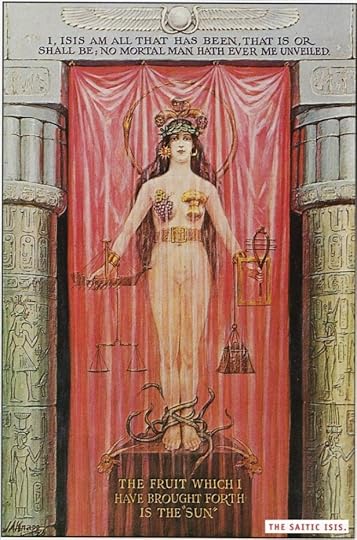 The Saitic Isis by John Knapp, 1928
The Saitic Isis by John Knapp, 1928We do have some Isis-themed bits here: a powerful, Goddess-like magician, secret knowledge, immortality, love, sex—all in a lost city more ancient than ancient Egypt. In a sequel to She (of course there was a sequel)—Ayesha: the Return of She—Haggard tells us that Ayesha’s name is to be pronounced “AH-sha” which is slightly reminiscent of Isis’ name in late Egyptian: Ise or Ese. The sequels also include “an ancient sistrum” and a rock formation in the form of an ankh for some clear Egyptian ambiance. Haggard’s novel fits right in with the significant case of Egyptomania Europe was giddily undergoing at the time. Haggard himself was deeply interested in Egypt and wrote another novel, Morning Star, that was set in ancient Egypt and featured a strong-willed Egyptian queen as protagonist.
In an article I’m reading by Steve Vinson, he suggests that some aspects of She, may have come from the tale of Ahwere and the Magic Book, a tale you already know has Isis connections. You’ll find those here and here. In addition to the focus on magic and some name similarities in the two tales, the dramatic power and alluring beauty of Ayesha is similar to the power and allure of Tabubu in Ahwere’s story.
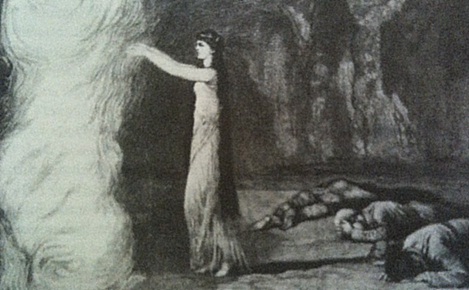 Ayesha steps into the fiery Pillar of Life
Ayesha steps into the fiery Pillar of LifeYou might also remember Aithopika, the ancient Greek novel by Heliodorus, that also has Egyptian and Isis connections. Re-read those here. Vinson notes those and other similarities as well. In both novels, there’s an adventure in Africa where the young protagonists discover their true identity. In the case of She, it is Holly’s adopted son Leo who finds out that he actually IS a descendant of Ayesha’s lover, Kallikrates. Kallikrates is Greek and married to the Egyptian Amenartas, a priestess of Isis. The power of Isis protects Amenartas from the wrath of Ayesha when Kallikrates refuses to kill her. Vinson notes some similarities between the stories of Kallikrates and Aithopika‘s Isis priest Kalisiris, as well as quite a few plot points that indicate the influence of Aithopika on She. But those mostly don’t concern Isis, so I won’t detail them.
Vinson also finds parallels in the portrayals of Ayesha and other strong female leaders in Haggards’ stories with the character of Isis Herself, as well as with the Isis-connected protagonists in these ancient Egyptian and Greek tales.
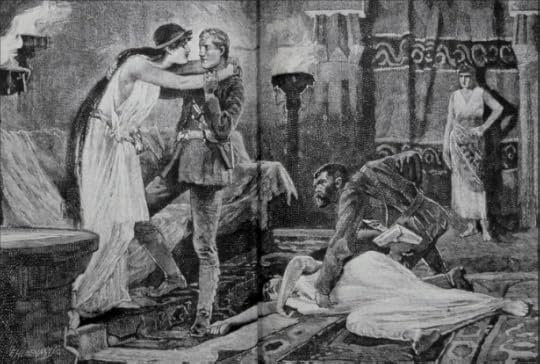 Ayesha and Kallikrates, illustration for She by Maurice Greiffenhagen, 1888; it’s all pretty Egyptian looking
Ayesha and Kallikrates, illustration for She by Maurice Greiffenhagen, 1888; it’s all pretty Egyptian lookingIsis was, quite simply, the most well-known Egyptian Goddess in Haggard’s time, and with Her multi-facted nature, it would be hard not to be able to find almost any type of Isis you’d like—from kindly to avenging. Isis embodies sexual power, too; see here and here, though She is not generally portrayed as a Great Seductress. Haggard had to turn to Isis-connected characters like Tabubu and Rhodopis (a courtesan in Aithopika) for that.
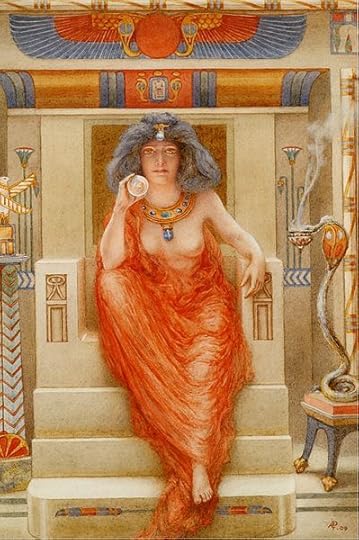 Isis by Armand Point, 1909
Isis by Armand Point, 1909Isis looms large in the Victorian era, with its Woman Question and Egyptomania. Ancient stories like the ones we’re talking about intrigued readers and inspired writers like Haggard and others. Translations of Plutarch’s works, including On Isis and Osiris, made Isis’ story, and Her famous veil, more widely known, while Madame Blavatsky’s opus Isis Unveiled established Her in the occult world.
As far as Europe is concerned, I don’t think it’s too much to say that Isis served as THE prime example of Feminine Divinity during this period. What’s more, as a feminine Being with both power and authority, She served as an inspiration for the New Woman of first-wave feminism. Remember Margaret Fuller?
From the world of the sciences to the arts to the occult, Isis was strongly present. Scientists worked to draw aside Her veil to reveal the secrets of Nature. Artists and writers were inspired by and wrote about Isis and Egypt. Occult groups such as the Hermetic Order of the Golden Dawn, incorporated Her prominently into their magical systems.
If any Goddess was THE Goddess in late-19th, early-20th-century Europe, it was Isis. Indeed, it would be surprising if Haggard’s Ayesha was not inspired by some aspects of the Goddess Who was so well known in his day
*Ayesha or Aisha is also a wife of the Islamic prophet Mohammad and a well respected figure in Sunni Islam. The name Ayesha was very popular during the Ottoman Empire and it came to symbolize all-things-Arabian to 19th-century English readers. Many English novels and stories featured characters named Ayesha.
**I know. The math don’t quite math with Ayesha being over 2,000 years old and being born an Arab, but okay.
March 13, 2025
SunFest 2025: The Return of the Wandering Goddess
June 27-29, 2025 Portland Oregon area
Bonus post this week because I’m excited to tell you about our upcoming summer solstice festival for 2025. SunFest 2025 is being put on by Other Worlds of Wonder (OWOW), please visit their website at the link below. I am serving as ritual facilitator—along with a truly wonderful Crewe of ritualists and craftspeople. It is going to be pure magic!
The Myth of the Wandering Goddess is one of the two most important myths of ancient Egypt. Just about every town or region had its own version of the festival that celebrated this myth. Although different Goddesses were the “Wandering Goddess” in each local area, our festival celebrates the power of Sakhmet and the ecstasy of Hathor.

During SunFest 2025, we’ll explore this important myth in a highly immersive, highly participatory way. Each ritual, presentation, or workshop is designed to draw us into the overall myth so that—together—we will live our own version of that myth as well as celebrating the festival that surrounded it.
The festival takes place Friday through Sunday. Every ritual or event brings us into the myth/s and the ancient festival so that we can discover more about these Great Egyptian Goddesses for ourselves.
Friday
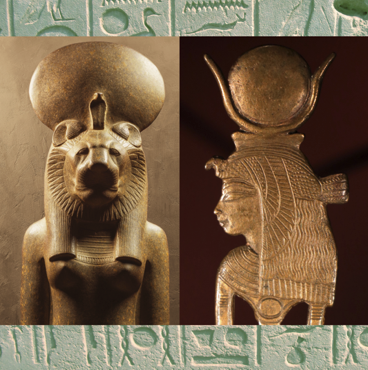
Creating Altars & Invoking Hathor & Sakhmet
Our first ritual act is to create altars for the Goddesses and to invoke Their presence to our festival. You’re invited to bring items to add to the altar. We will create it together as part of the rite. Then, with the altars prepared, we invoke our two festival Goddesses, the Fierce Goddesses of the Solar Eye: Hathor, the Golden One, and Sakhmet, the Powerful One.
Through our desire, through our invocations, through our music, and our moving bodies, we call upon our Goddesses to be present with us during this festival.
Sedj Desherut, the Ritual of Breaking Red Pots

The ancient Egyptian Ritual of Breaking Red Pots was performed to protect against enemies, physical and/or spiritual. Archeologists have found fragments of the pots that had been inscribed with curses against said enemies. In our version, we will join with Sakhmet in Her righteous anger against the injustice in the world and smash our own “red pots.” By expressing our rage, both personal and societal, we begin the Sacred Work of becoming purified and renewed.
At the end of this ritual, the Goddess Sakhmet departs from us and we are now without the powerful protection of our Goddess.
Seducing Sakhmet, Dancing for Her

The Hathoru, sacred enticers of the Goddess Hathor, will help us get the Friday night drumming and dancing going with a calling for the absent Goddess and a chant to seduce Her to return.
Opening the Temple of Hathor the Beloved
The Servants of Hathor will formally open the “tantric temple” for adults to enjoy the sensual pleasures that honor the Goddess Hathor the Beloved.
Saturday
Workshop: The Myth of the Wandering Goddess
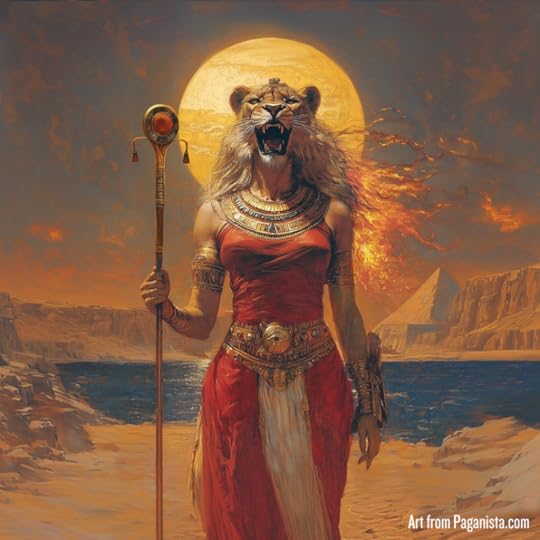
I’ll present a Keynote talk to explain the importance of this myth to ancient Egypt and provide background to help us understand the rituals and activities of the festival.
At the end of the presentation, we’ll have the opportunity to experience the energies of both Sakhmet and Hathor for ourselves.
Sehotep Sakhmet; Pouring Out Red Beer for Her
Five gallons of red beer are being ritually brewed as an offering to Sakhmet, so that we may appease Her wrath and coax Her to return to us. Without our Fierce Goddess, we, like the Sun God Re, are vulnerable. The First Servant of Sakhmet will lead us in a prayer and chant to the Goddess. Then we will pour out the blood-red beer into the fields in hopes that the Goddess will be pleased and made peaceful through it.

Workshop: Creating Offerings
We’ll break into 5 groups, our “villages.” Each village will work together to create an offering for the Returning Goddess—as She has been promised by Thoth, the God of Wisdom, if She agrees to return home.
The Return of the Wandering Goddess; Hathor is in Joy
Wise Thoth has followed the Lioness Goddess to Nubia and has entertained Her with many excellent tales. He has coaxed Her to return home, promising offerings, dancing, and feasting in Her honor.

Join us at the riverbank, our isheru, where the Returning Goddess is renewed in the Deep Primordial Waters. We, like our Goddess, will be purified and renewed as well. By our rites and in these Waters, Red Sakhmet transforms Herself into Turquoise Hathor, the Intoxicating One.
Then we walk together in procession as we make music and throw flower petals in the path of the Returning Goddess—and at each other, if we’re feeling playful. The Goddess’ reed boat stops at each village and we present our offerings to Her.

Community Picnic
We join together in the main meadow to feast with our Community and in honor of our Goddesses, Hathor and Sakhmet, and Thoth.
Blessings of the Seven Hathors
As the sun sets, we are called once more to gather at the Fire Circle. The Goddess will be present in 7 different forms and She will bless us in return for the offerings we created and presented to Her earlier.
There is no formal end to the ritual. We drum and dance our way into the night as we so desire.
Sunday

Pouring Out Pure Milk for Her
This is the closing ritual for the festival. We pour out pure milk in thanks to Sakhmet, Hathor, and Thoth, then ritually release Their Presences by extinguishing our fiery torches in the sacred milk of the Goddess.
The rite also incorporates OWOW’s traditional gift exchange. If you wish to participate, bring a small gift with you as a thanksgiving to be given to someone in our community, and you will receive one in return.

PLUS—Other workshops on Sunday!
How to Register
March 9, 2025
Is Isis Calling Me?
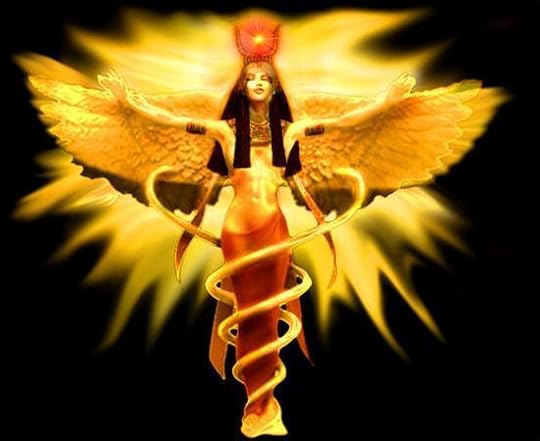
The is one of the most popular posts on Isiopolis. I’m reposting it today as I’m totally booked—with all kinds of good things. Goddesses, magic, and wonderful people! Hope you’ll enjoy it a second time around.
One of the questions I regularly receive from folks who email me is, “how can I tell if Isis is calling me?”
It’s a very good question, if a somewhat difficult one to answer. Sometimes, people have had dreams with what they think could be Isiac imagery. Sometimes they’ve had a vision or some other experience during a ritual. Sometimes it’s a feeling, sometimes a wish or a hope.
What Do We Mean by “Calling”?
To try to unravel this, the first thing we need to figure out is what we mean by “calling?” In other words, if She were calling us, what would that mean? What kind of obligation, if any, comes with that calling? Because so many of us have Christianity in our personal backgrounds as well as Christianity being so prominent in our societies, we might automatically associate “a calling” with a vocation for the ministry or priesthood. It’s certainly possible. But there are other possibilities, too.
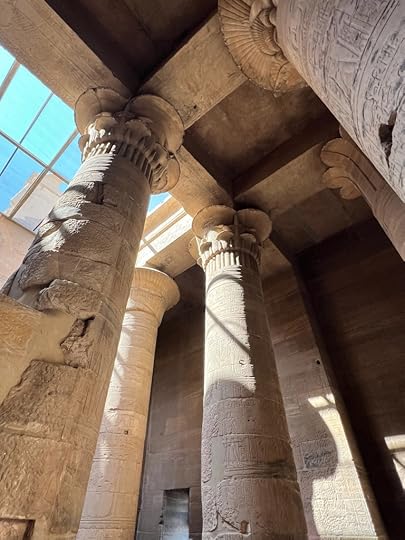
What calling means to us can also depend on where we are in our spiritual journey, as well as what we’ve been studying or reading or thinking.
For instance, let’s say you’re very interested in ancient Egypt, you’ve been reading about it, and you’re in a spiritual circle of some kind that regularly invokes Deities. Then one night, you have a powerful dream in which a beautiful, Egyptian woman seems to welcome you. You think She might be Isis. She might, indeed. She could also be one of any number of Egyptian Goddesses, which you would know about from your reading. What you intuit from your own dream will be very helpful here. If you think She’s Isis, you can follow that thread. We’ll talk about that shortly.
For another instance, let’s say you’ve never had any particular connection with ancient Egypt and you’re not on any specific spiritual path. Then one night, you have a powerful dream in which a beautiful, Egyptian woman seems to welcome you. You think She might be Isis. This may be just a dream. But if you find it exceptionally powerful, keep looking. A dream like that might be pointing out that your soul is yearning for some positive Mother or Divine Feminine energy in your life. That knowledge, in and of itself, is very valuable information. On the other hand, such a dream could be the impetus to set you on a spiritual journey as you seek to learn more.

And for a third instance, let’s say you have that same dream. But you don’t feel that you’re ready—or that you even want to—do anything about it. You absolutely don’t have to. If it’s an important knock on your spiritual door, She’ll knock again. And it’s okay to say no. You won’t hurt Her feelings and there are no negative consequences.
Dreams & Signs
So. Dreams are one way to hear Isis if She’s calling you. But if you, like me, are a crappy dreamer and neither remember them nor write them down, there are other ways to hear Her. There are usually signs. Signs can be tricky. In most cases, a sign is something unusual that catches your attention and relates to the particular Deity involved, in our case, Isis. Because She is a Bird Goddess, it might be wings and feathers. You may hear the sound of wings at an odd time. Or a bird swoops down immediately in your line of sight, startling you. Or a feather drops from the sky. Her symbols—like the Knot of Isis or a throne—might show up unexpectedly. Perhaps you overhear Her name in a passing conversation between strangers. This will happen, not just once, but many times. Be patient. Wait. And look and listen for the signs.
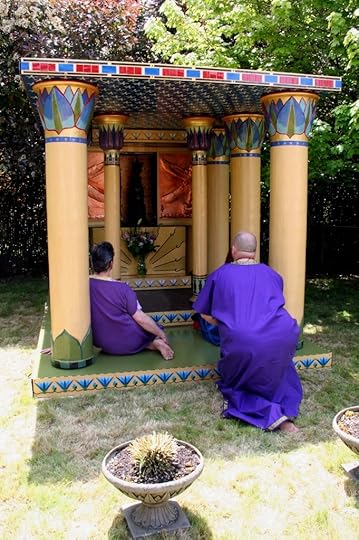
Now, if you’re actively wanting Her to be calling you, signs and synchronicities can ramp up. Does a breeze rustle the leaves of a tree as you pass, thinking of Her? It is Her breath. Have you found a piece of jewelry engraved with Her image? She confirms your Path. Did that hawk circle above you as you drive your car down a country road with Her name on your lips? She is guiding you.
Is it foolish to see these signs everywhere? Is it “just my imagination?” In some cases, sure, there will be a kind of confirmation bias. But that doesn’t matter; She’s on your mind. You’re thinking of Her. It has begun.
Sometimes, there are other ways to tell. You might have an intuition of Her presence about you. Or something weird might happen. I’ve had incense burn and disappear all by itself, strangers have given me unexpected Isis gifts, very loud disembodied voices have spoken my name. What your weird thing might be, I can’t say.
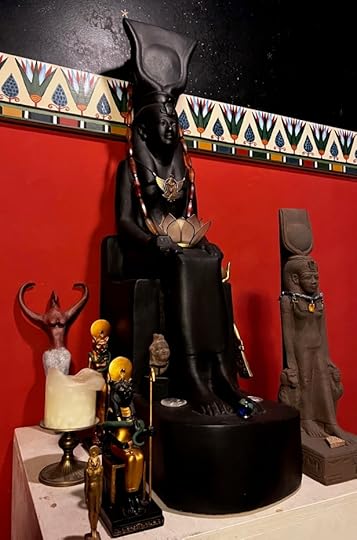
Pick Up the Phone Yourself
Now. There’s also an important secret about all this that I’d like to share with you. Two, really. The first is that if you want to connect with Isis, you don’t have to wait for Her to call you. You can call Her, too. Light a candle. Say a prayer. Ask Her to come into your life. If you like ritual, use the Opening of the Ways here.
The second is that being called by Isis doesn’t necessarily mean you are being called to a lifelong relationship with Her. It doesn’t necessarily mean you’re being called to serve as Her priestess, priestex, or priest. It might mean you’re being called to learn more about Her—right now and perhaps only for a while. Perhaps you’re being called to relationship. And like any relationship, that means investing time. Spend time with Her, in meditation and prayer. Read about Her in anything and everything you can get your hands on. Get to know Her. See how She feels to you. Do you like Her energy? Does it fit with yours? That’s what I mean by following the thread…and just see where it leads you.
And if you find, after time, that this is not the relationship for you, that’s perfectly okay. You will have learned. You will have grown and your spiritual world will have been expanded.
But if you find that, like me, you are a lifetime (or at least long term) devotee of Isis, then I know you will discover for yourself Her deep love, wisdom, power, and magic.



